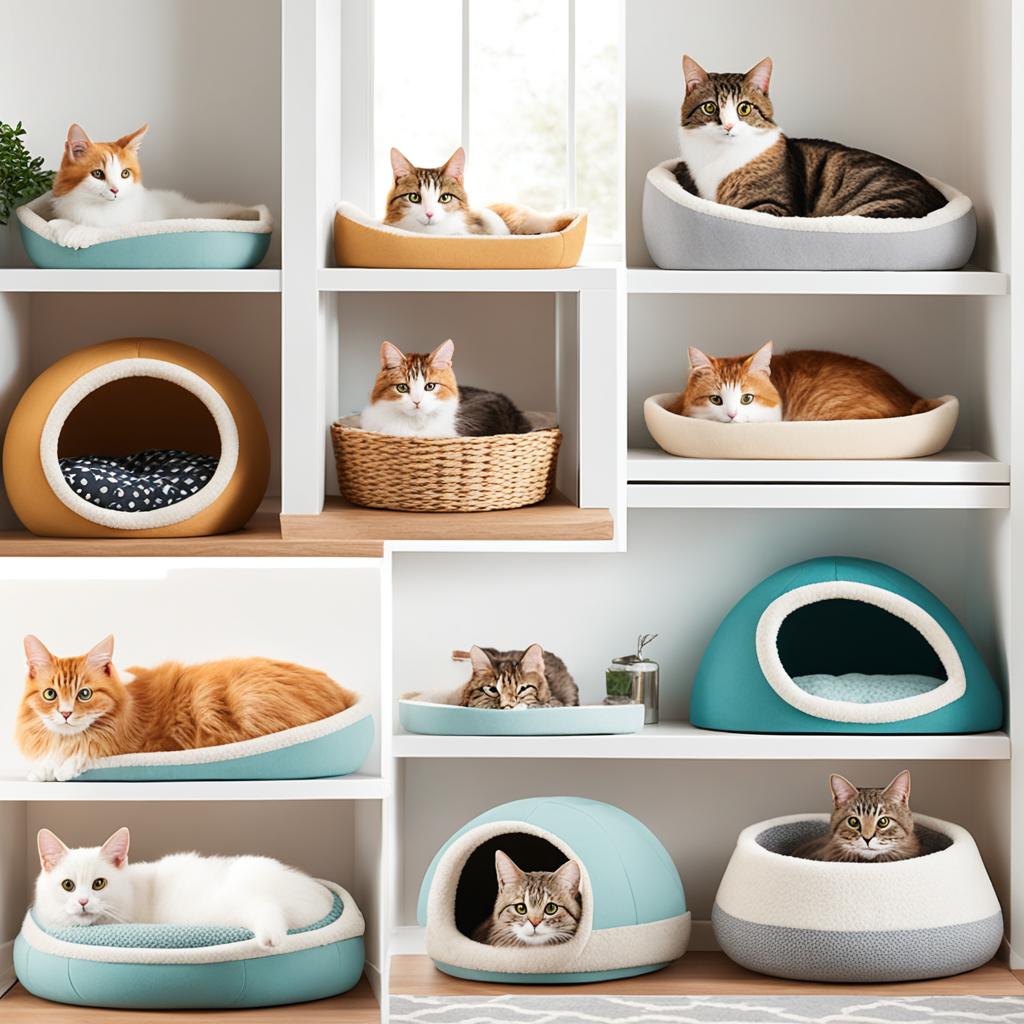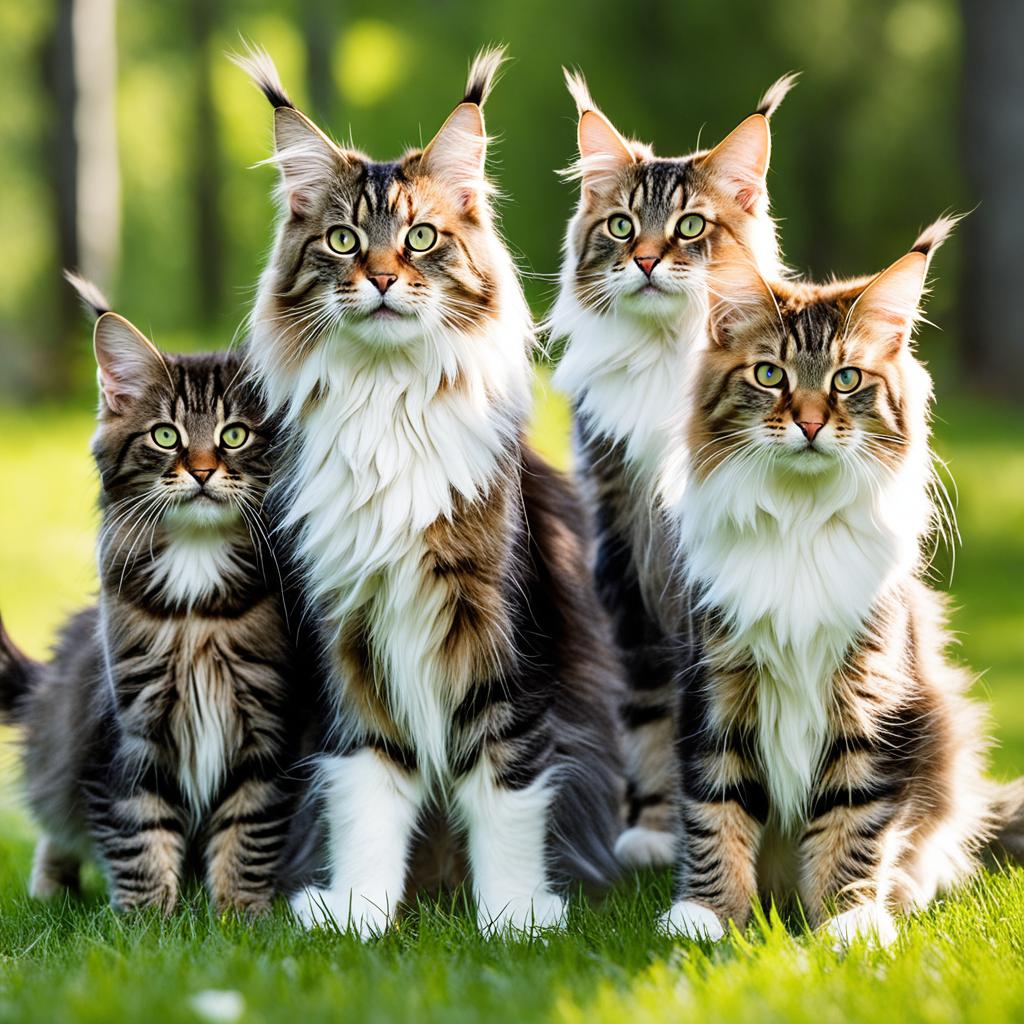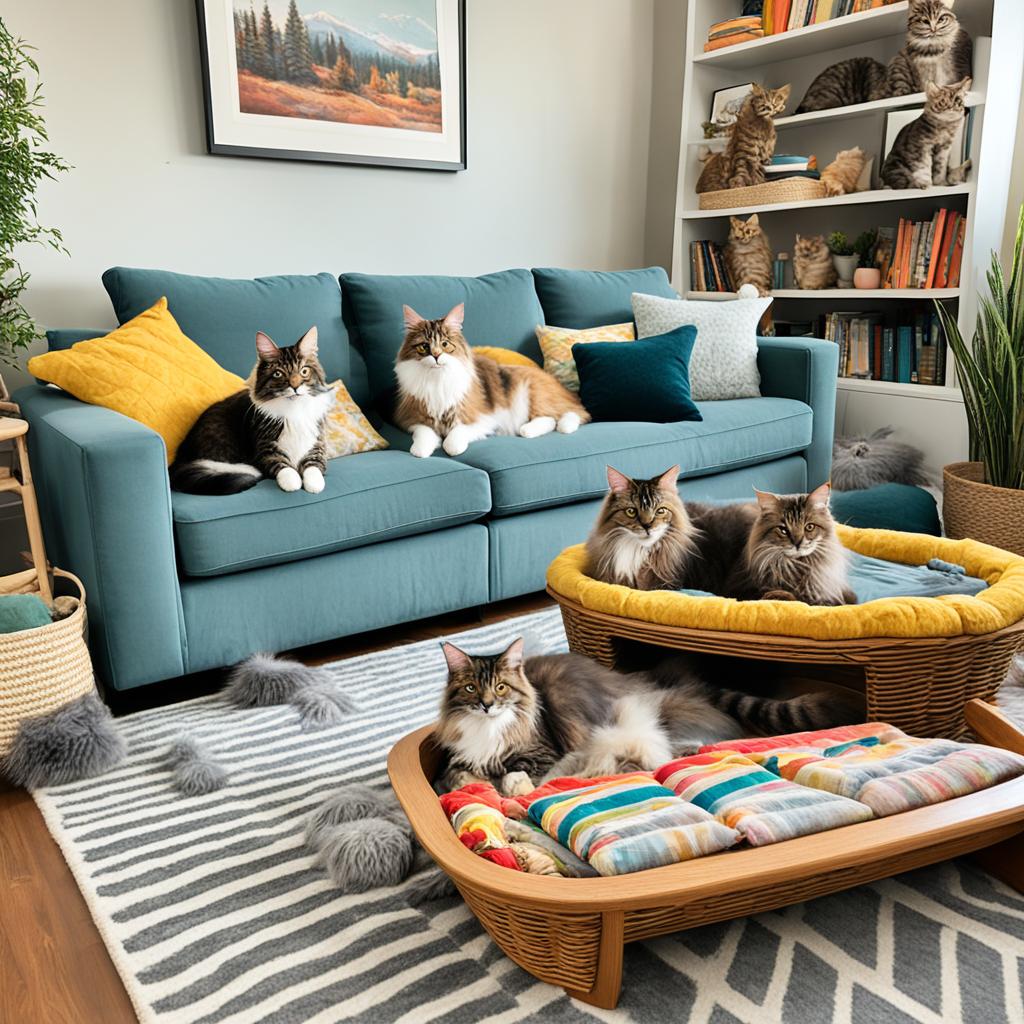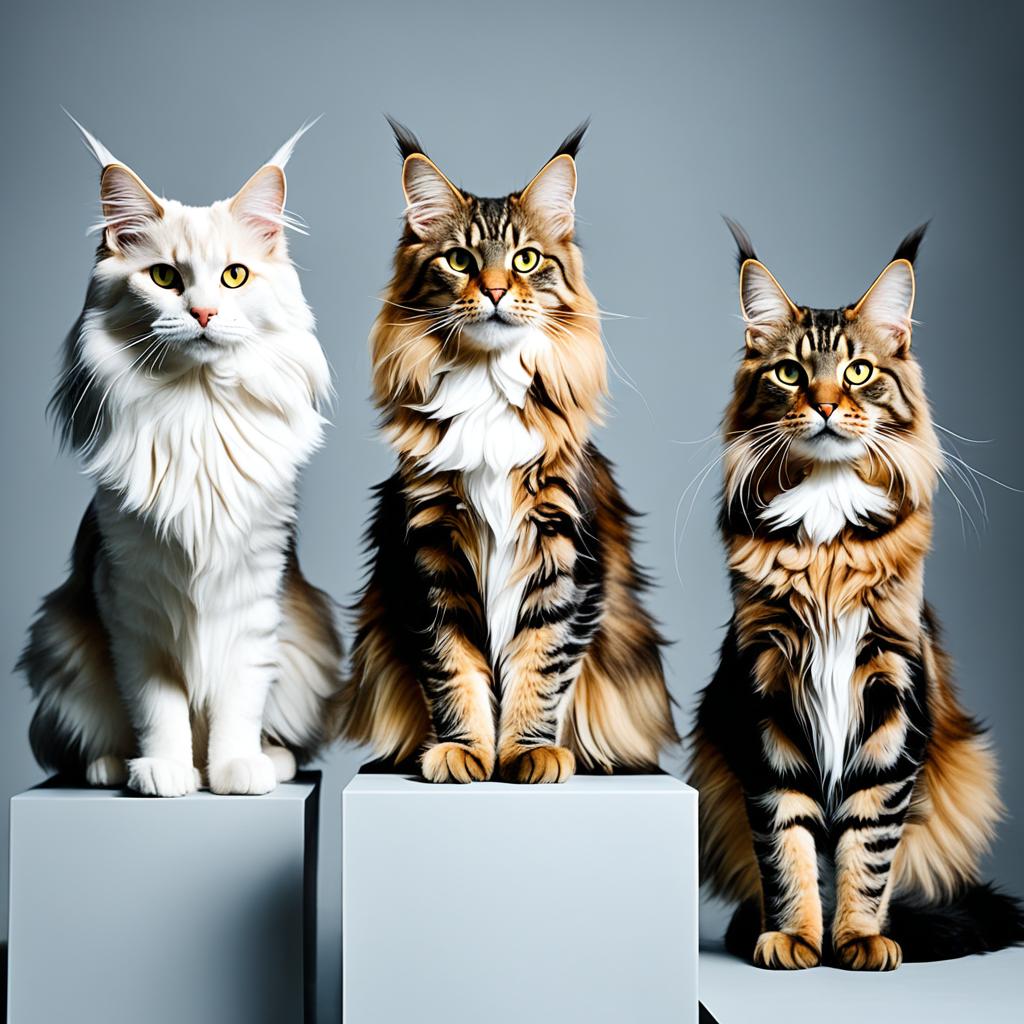Maine Coons are known as the biggest house cat breed, sometimes weighing up to 18 pounds. Picture this: you have a gentle giant Maine Coon meeting your new, shy 2-year-old cat and her playful 6-month-old kitten. The big size difference might scare the new cats. So, it’s key that your Maine Coon is friendly but not too pushy.
To make a Maine Coon meetup work, you have to be careful and patient. At 11 months old, your Maine Coon will be curious and full of energy. But, the secret is to let their fun side show slowly. This makes the meetups less scary for everyone. You need to understand each cat and know how to introduce them to keep the peace.
Key Takeaways
- Maine Coons can be quite large compared to other cats, necessitating a cautious introduction.
- Friendly playfulness of the Maine Coon needs to be introduced gradually to avoid overwhelming timid cats.
- Creating smooth and stress-free introductions is essential for successful socialization.
- Empathizing with each cat’s ability to adapt makes the entire introduction process smoother.
- Using specific techniques can aid in creating harmonious interactions during a Maine Coon meetup.
Understanding Maine Coon Cat Behavior with Other Cats

Introducing your Maine Coon to other cats can be a challenge. These big, friendly cats stand out because of how they interact with others. This makes their interaction with different cats interesting to watch.
Why Maine Coons Are Unique
Maine Coons are known for their friendly nature. They are more outgoing and less picky about their space than some cats. Being big, they might seem scary at first, but they’re usually very sweet. This makes them a good addition to homes with several cats. It’s important to know this when trying to mix them with other felines.
Common Behavioral Traits
Maine Coons love to play and make friends with other cats. But, their large size might be too much for smaller or shyer cats. It’s good to notice when they gently bump heads or groom each other. These are signs they like each other. Yet, always watch out for any negative feelings. Keeping an eye on their stress levels is key to them living in peace with other cats.
| Behavior Trait | Description |
|---|---|
| Head-butting | A sign of affection and trust. |
| Mutual Grooming | Indicates a strong bond and acceptance. |
| Playfulness | Engaging and interactive, often leading social interactions. |
| Purring | Shows contentment and relaxation. |
Preparing Your Home for a New Cat Introduction

Adding a new cat to your home is always thrilling. Making the change smooth for everyone is key. This is particularly true when welcoming a Maine Coon. Their size and unique traits need special attention.
Creating Safe Spaces
Maine Coons love having their own quiet areas. By setting up safe spaces for cats, you help your new friend feel at ease. These could be hidden nooks, climbing spots like cat trees, or even whole rooms just for them.
Necessary Supplies and Resources
Having the right Maine Coon cat introduction supplies is crucial. You’ll need separate food and water dishes, litter boxes, and scratching posts to prevent fights. Place these items in various spots to give each cat their own area, ensuring peace.
| Supplies | Quantity Needed | Notes |
|---|---|---|
| Food Bowls | One per cat | Place in separate areas |
| Water Bowls | One per cat | Keep fresh and clean |
| Litter Boxes | One more than the number of cats | Each cat should have easy access |
| Scratching Posts | Multiple, spread around the house | Encourages healthy scratching |
| Safe Retreat Areas | One per cat | Ensures privacy and comfort |
Setting up the home right for Maine Coons is about knowing what they need. Providing for their unique characteristics ensures a friendly home for all cats.
How to Introduce a Maine Coon Cat to Other Cats?

Introducing your Maine Coon to other cats takes care and thought. It’s important to approach it step by step. By using specific techniques, you can make sure all cats involved feel safe and happy.
Step-by-Step Introduction Process
Start by giving each cat their own space. This allows them to get used to their new surroundings without pressure. It’s a key step in avoiding conflicts early on.
- Scent Introducing: Trade bedding or towels between the cats first. This trick lets cats smell each other in a stress-free way. They get to know each other’s scent without direct contact.
- Visual Contact: After some days, let the cats catch a glimpse of each other through a door crack or a gate. This helps them slowly become familiar with the other’s presence.
- Guided Meetings: Move on to short in-person meetings that you can watch over. Make sure these interactions are positive by rewarding them with treats.
- Increase Interaction Time: As they get more comfortable, extend the time they spend together. Be ready to step in if things get rough. But do so in a way that keeps the atmosphere positive and relaxed.
Using Scent Swapping Techniques
For cats, sharing scents is like sharing a handshake. It’s how they recognize each other. Here’s how to swap scents effectively:
- Exchange Bedding: Swap beds or blankets between the cats. It helps them get used to the other’s scent in a safe way.
- Rub Cloths: Rub a cloth on each cat’s cheeks and then put them in the other cat’s area. This helps the cats feel like they’ve already met, making real introductions easier.
- Use Pheromone Sprays: Think about using sprays or diffusers that imitate cat pheromones. They can calm your cats during these early meetings.
By sticking to these introduction steps, you set the stage for an easier, stress-less merging of your Maine Coon with new friends. Watching over and changing things gradually will make a big difference. These simple steps make learning how to introduce a Maine Coon Cat to new cats a smoother experience.
Maine Coon and Kitten Introduction Tips

Introducing a Maine Coon to kittens can be a wonderful journey with the right preparation. It’s vital to start with know-how and prep work. Doing so helps the Maine Coon and kittens build a good relationship from the get-go. Here are essential tips to guide you through this process.
Understanding Kitten Behavior
Knowing how kittens behave is key when bringing them together with a Maine Coon. Kittens love to explore but can get scared of a Maine Coon’s size. It’s important to tell if a kitten is just being playful or really scared. A hiss might just be a sign of being unsure, not trying to pick a fight.
Monitoring Initial Interactions
When your cat and kittens first meet, keep a close eye on them. This helps avoid any scary situations. Always be nearby in case the Maine Coon gets rough while playing with the kittens. If you see the kittens hiding or making a lot of noise, they might be feeling stressed.
Understanding your kittens and Maine Coons and keeping a watchful eye is crucial. This approach helps them start their relationship on a good note.
| Key Tips | Benefits |
|---|---|
| Gradual Introduction | Reduces Anxiety |
| Supervised Playtime | Encourages Safe Play |
| Separate Retreat Spaces | Provides Security |
Handling Multi-Cat Households

Living with multiple Maine Coons can be an adventure. They bring a lot of energy and love. Making sure they all get along takes some strategy, though. You need to be smart about how you manage their space and things.
Setting Up Separate Resources
A top rule for keeping many cats happy is: separate resources for multiple cats. This means having more than one of everything – food bowls, water dishes, etc. Each cat then has its own area that it knows is just for them. This stops fights over who gets what. It also helps you keep track of what each cat is eating and drinking. Everyone gets their fair share this way.
Managing Territorial Disputes
Maine Coons, even the friendliest, sometimes claim their space. Dealing with this territorial behavior in cats can seem tough. But, making sure there are plenty of places, like cat trees and windows, where they can feel like the king or queen, really works. Understanding and respecting their need for space can make your home a peaceful place for them all.
Signs of Successful Maine Coon Cat Integration

Understanding how to recognize successful Maine Coon cat integration is key. It ensures a peaceful home for all your cats. You’ll learn what to look for to keep things running smoothly.
Positive Interaction Clues
Looking for signs of feline positive interactions is a good start. One big clue is when cats groom each other. This shows they’re close and care for each other. Seeing them play or sleep together peacefully also means things are going well.
Behavioral Red Flags to Watch For
But there are also things to watch out for. Signs like a cat hiding a lot can hint at problems. And if they avoid some areas or make one their own space, this could show they’re not getting along.
Guards around food, water, or sleeping spots are also a bad sign. Catching these problems early can stop them from getting worse. This keeps your cats happy and your home calm.
Common Challenges and How to Overcome Them

Adding a Maine Coon to your other cats takes time and planning. It’s vital that all cats feel safe and can get to their things. Knowing cat behaviors helps make them get along better.
Dealing with Aggression
You can make different areas for each cat in your home. This helps them feel like they’re in charge. Watch how they act together, and step in if things get rough.
Have toys or treats at hand to turn bad moments into good ones. This shows them they can share without fighting.
Promoting Peaceful Coexistence
It’s important to keep the atmosphere calm for all cats. Diffusers or sprays can help. Make sure each cat has its own eating, bathroom, and sleeping spot to avoid clashes.
If things are still tough, a behavior expert can give personalized advice. They might suggest steps specific to your cats.
| Challenge | Strategy |
|---|---|
| Cat Aggression | Separate zones, use distractions, offer toys and treats |
| Resource Competition | Provide multiple feeding areas and litter boxes |
| Stress Management | Calming sprays, professional advice |
Best Practices for Introducing a Maine Coon to Other Cats

Introducing a Maine Coon to new cat friends takes care. It’s vital to be patient and make smart choices. Because Maine Coons are big and love company, they need a careful introduction to other cats.
Using Gradual Introductions
A slow start is the best way to introduce a Maine Coon to other cats. Jumping straight to face-to-face meetings can shock them. Begin by letting them get used to each other’s smell. Swap their bedding or use special toys for this.
- Step 1: Scent swapping – exchange bedding or toys between cats.
- Step 2: Controlled visual introductions using barriers.
- Step 3: Short supervised face-to-face meetings.
Incorporating Play and Treats
Play and treats really help cats get along. Playtime can make Maine Coons see other cats in a good light. Have fun play sessions with all the cats, using toys they like. Then, give them treats to reward good behavior.
- Engage in group play sessions with interactive toys like feather wands.
- Provide treats at the end of each play session to reward positive interactions.
- Monitor body language and adjust the environment based on the cats’ comfort levels.
To introduce a Maine Coon successfully, a slow start and fun play are key. With time and positive vibes, your cats can live together happily.
Socializing Maine Coon Cats at Meetups
Introducing your Maine Coon to new friends or going to a cat meetup is important. It lets your cat socialize in a safe place. But, it’s vital to prepare well for these events. Good preparation and careful attention ensure your cat has a great time meeting others.
Preparing for a Cat Meetup
First, know your Maine Coon’s social signals. These cats are usually friendly and outgoing but can get nervous around new people and cats. Help your cat by making sure they are okay with traveling. Bring some of their favorite things to make them feel secure. It’s also key that your cat’s vaccinations are current to protect them from illnesses.
Managing Interactions During the Event
At the meetup, watch how your Maine Coon interacts with others. Look for any signs of trouble, like being scared or aggressive. Be prepared to step in if needed. Reward your cat with treats and kind words for getting along well with others. Being patient is crucial. Let your cat decide how fast to approach others. This helps them feel more at ease and grow their social confidence.
Treat every cat’s comfort zone with respect. Slowly introducing them to new buddies will make these meetups fun for your furry friend.
FAQ
Why are Maine Coons unique in their behavior with other cats?
**A:** Maine Coons stand out with their friendly ways. Their big size and fun-loving attitude make them ideal friends. Still, you need to be careful with smaller or shy cats.
What are common behavioral traits of Maine Coons?
**A:** These cats are big, but often love to play and show affection. They’re curious too. They usually get along with other pets, yet they can be a bit territorial. Understanding these traits helps with their care.
How should I prepare my home for a new cat introduction?
**A:** Start by making safe spots for each cat. This helps them feel secure. Also, have plenty of food, litter, and things to scratch in different places. This stops fights over territory and stress.
What supplies should I have when introducing a Maine Coon to other cats?
Have extra food and litter areas. Also, give them more hiding spots, beds, and toys. This means each cat feels safe and there’s less fighting over space.
What is the step-by-step introduction process for a Maine Coon and other cats?
**A:** First, swap scents using things like blankets between the cats. Then, let them see each other through something like a baby gate. Finally, after they’re used to each other’s scent, let them meet. Supervising these early meetings is key to avoid stress and fights.
How does scent swapping work in introducing cats?
**A:** Scent swapping helps cats get to know each other before they actually meet. Rub a cloth on one cat to gather its scent. Then put it near the other cat. This helps them feel more at ease with the other’s smell.
Any specific tips for introducing a Maine Coon to a kitten?
Remember, kittens are small and can be scared by a Maine Coon’s size. Watch them closely at first, making sure play stays gentle. This ensures a safe and calm introduction.
How can I set up separate resources in a multi-cat household?
Give each cat their own food, litter, and sleeping spots. Spread these out. This encourages harmony and reduces fighting over space.
What should I do if territorial disputes arise?
If you see fighting over areas, change the layout. This includes blocking their view of each other and adding vertical spaces. Also, ensure there’s enough for everyone. Separating them for a while and then slowly bringing them back together can also solve the issue.
How can I recognize successful integration between my Maine Coon and other cats?
**A:** Things like grooming each other and sleeping together in peace are good signs. If they’re relaxed and get along, they’re likely adjusting well.
What are behavioral red flags to watch for during integration?
**A:** Watch out for cats hiding, hissing, or fighting. These are signs of serious tension. If you see these, it’s time to step in to keep the peace.
How can I deal with aggression during cat introductions?
Keep the setting calm and make sure each cat has what it needs. Slowly introduce them. Sometimes, getting advice from a behavior expert is needed for aggressive cats.
What are some best practices for introducing a Maine Coon to other cats?
**A:** Go slow with the introductions. Use encouraging play and rewards. This makes the process positive for all involved.
How should I prepare my Maine Coon for a cat meetup?
Know your Maine Coon’s social comfort level. Make sure they’re up-to-date with shots and ready to meet new cats. Bringing familiar items can provide comfort at the meetup.
How can I manage interactions during a cat meetup?
**A:** Always watch the cats closely. Respect their space and be prepared to stop any trouble. Being patient and understanding helps make the meetups go well.
Source Links
- https://www.humanerescuealliance.org/blog/posts/tips-for-a-successful-meet-and-greet-with-a-cat
- https://www.reddit.com/r/mainecoons/comments/188bruc/any_advice_for_introducing_a_normal_kitten_to_a/
- https://www.petplan.co.uk/pet-information/blog/is-it-a-good-idea-to-have-more-than-one-cat-in-your-home/




